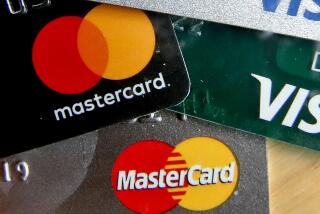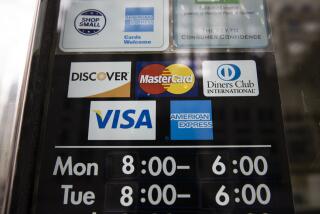The Penchant for Plastic Extends to Mom and Pop
- Share via
Where are America’s small-business owners increasingly turning to find easy financing for their companies? The same place they charge everything from movie tickets to college tuition: credit cards.
That’s one of the findings of an annual survey to be released today documenting the state of America’s small businesses, which appear to be mimicking consumers in their growing addiction to plastic.
More than a third of business owners surveyed said they use credit cards to finance everything from office supplies to inventory and equipment. That’s nearly double the 17.3% recorded in 1993, according to the study’s authors, National Small Business United, a Washington-based advocacy group, and Arthur Andersen’s Enterprise Group, which specializes in consulting for small and medium-sized companies.
Industry watchers say the figures underscore the easy availability of credit. A fistful of plastic gives business owners instant access to thousands of dollars in much-needed capital without the hassle of filling out loan documents.
If they use their credit without incurring a lot of debt, small businesses can finance short-term growth with their gold cards for about what they’d pay for traditional bank loans or lines of credit. But charging can be expensive over the long haul, and it can be downright fatal to a fledgling enterprise if the card balances spiral out of control.
“It may be easier to flash the plastic, but in the long run, working hard to find an alternative means of financing is prudent,” says Sharon Miller, a Michigan-based small-business owner and chairwoman of the NSBU.
At first blush, the concept of small-business owners using credit cards to bankroll their companies dredges up images of desperate entrepreneurs turned away by traditional lenders. But 77% of the nearly 1,000 business owners surveyed said they had access to adequate financing.
For many mom-and-pop companies, credit card usage is a prudent, calculated strategy to help them manage their cash flow and cut down on paperwork, according to Nancy Pechloff, managing director of the Enterprise Group.
Pechloff said 60% of the small-business credit card users surveyed said they pay off their balances in full each month, thus avoiding interest charges. For these firms, taking advantage of the float amounts to an interest-free loan. And writing a single check to the credit card company is faster and cheaper than mailing dozens of separate checks to suppliers.
“Small-business owners are simply being opportunistic,” Pechloff said. “For many of them it’s an advantage . . . not a liability.”
Credit card issuers are fueling this “charge it” mentality by rolling out new cards aimed at small businesses. Barely a year after introducing revolving credit cards for such firms, American Express has signed up 600,000 clients, according to Richard D’Ambrosio, spokesman for the company’s Small Business Services division.
“This is an extremely competitive market right now,” D’Ambrosio said. “. . . Small business is where the growth is.”
What’s more, the rates on some credit cards are quite competitive with traditional bank loans and lines of credit--sometimes even cheaper. For example, American Express offers a six-month “teaser” rate of 8.9% on its corporate Optima cards. That’s just a hair above the current prime rate of 8.5%.
“Heck, even a [Small Business Administration] loan is going to cost you [more than that],” says Harry Dictor, a small-business counselor for the SBA’s Service Corps of Retired Executives office in Glendale. “I had two clients come in this morning needing modest financing, and we quickly figured out they’d be better off using their credit cards.”
But experts also caution that plastic can become a trap, particularly for inexperienced business owners using their credit card companies as a lender of last resort. While bankers and venture capitalists require borrowers to lay out a disciplined, coherent business plan, credit card companies don’t care what an entrepreneur puts on the card as long as the money is paid back on time.
That kind of fast and loose financing can lead to poor business decisions, which are showing up in recent credit card delinquency statistics. At midyear, Americans had racked up more than $500 billion in outstanding revolving credit, most of it charged on credit cards. About 3.69% of those cardholders were behind on their payments in the second quarter, the second-highest level since the statistics have been compiled, according to the American Bankers Assn.
Although the ABA doesn’t calculate how many of those delinquents were small-business owners using plastic to keep their firms afloat, industry observers say that kind of financing is no doubt contributing to the high default rates.
“We’ve seen a big run-up in personal bankruptcies because a lot of so-called consumer debt was really people financing their businesses with consumer borrowing,” said Warren Heller, research director for Veribanc Inc., a Massachusetts research firm. “It’s the same thing here.”
Although commercial banks have moved aggressively to increase their lending to small businesses in recent years, business owners surveyed by the NSBU-Enterprise Group say they’ve reduced their reliance on that traditional source of financing to 37.8% in 1997 from 49.4% in 1993.
The trends aren’t necessarily contradictory, says NSBU President Todd McCracken. While banks are lending more because the overall number of small businesses is growing, individually those firms can now select from a wider array of financing options. Some are increasingly supplementing or even substituting bank loans with other forms of financing requiring much less paperwork, such as vendor credit, equipment leases and home equity loans, in addition to credit cards, McCracken said.
“It’s not that the banks are turning them away,” he said. “They aren’t going to the banks in the first place.”
Witness Lena Welch Ingram, who opened her Tifton, Ga.-based antique and gift shop in April. Ingram said she approached the SBA about funding but found out that “they basically want you to borrow $100,000.” She talked to her local banker about a line of credit, but the thick application intimidated her.
In the end, she relied on personal savings to purchase her building and turned to credit cards to purchase inventory and cover other start-up expenses--$18,000 worth of charges so far.
“It’s a lot of money, I know,” Ingram said. “But it was just easier, mentally and physically, to do it this way.”
More to Read
Inside the business of entertainment
The Wide Shot brings you news, analysis and insights on everything from streaming wars to production — and what it all means for the future.
You may occasionally receive promotional content from the Los Angeles Times.










